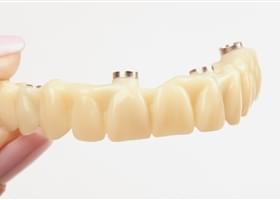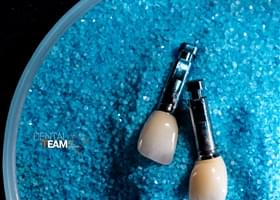

The category of implant prosthesis is characterized and differentiated, by the particularity of creating structures and devices that will be fixed on the implants or on the artificial supports and not on the natural tooth.


The importance and validity of this branch of dentistry is evident when the patient's natural denture does not guarantee an anchoring for solid prosthesis. After a careful analysis of the situation and the good health of both the supporting bone as well as the gum, the dentist prepares a medical diagnosis and can insert the implants (endosseous surgical screws) where the patient needs it during the operation.
Thus, a stable support is obtained and the dental technician can manufacture high quality structures and coatings using different technologies and materials.
Structure
The technologies used in the laboratory are extremely versatile. The production of the implant prosthesis structures, consequently, can be undertaken from different points of view, on the different working chains and with different materials. This great versatility not only allows to satisfy the demands of the dentist but also, and above all, those of the patient: positioning, flexibility, aesthetics and cost are all parameters that guarantee the manufacturing of a truly personalized device.
These structures, which will be later coated and placed in the patient's mouth (cemented or screwed), can be produced using the Cad/Cam technology process, Laser Melting and Cast Fusion , choosing the best solution based on the materials which may have physical limitations or not adapt to a particular manufacturing process. Take as an example the Titanium, this material can be milled or sintered by laser but not treated by Cast Fusion. Besides the Titanium (Cad / Cam Laser Melting) therefore, we can see structures in Cobalt Chrome (Cad / Cam, Laser Melting, Cast Fusion), Zirconium (Cad / Cam) that can only be milled and Gold-Alloy (Lega Aurea) ( Cast Fusion).
The works that can be carried out for this purpose are mainly:
COATING
The coatings available for these structures, regardless of the production process chosen, are based on acrylic resin or in layered ceramics. Although the resin is usually used only for short, medium and long-term provisional work, the quality / price ratio and the aesthetic performance of this material make it a usable solution, and used, even in finished Definite Toronto.
The quality and aesthetic precision that can be reached by the layering of ceramics remain unparalleled and often preferred thanks to the combination of the large chromatic choice available united with the skills and experience of the technicians specialized in this process.
In some cases the all-press ceramic technique is also used in which there is no differentiation between structure and coating. In this case the prosthesis, single crowns or small bridges, are pressed into lithium disilicate which upon completion are seen as a unique bodies that will then be cemented directly onto the artificial posts (abutment).
